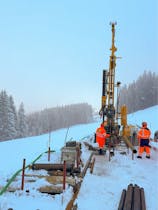
At the end of 2022, the Swiss Federal Office of Energy (SFOE) defined the «Glaubenberg» planning area for the Innertkirchen – Mettlen project. Planning areas are geographical areas in which Swissgrid will develop planning corridors, including transmission technology (underground cable, overhead line or a combined variant), as the project progresses. The Federal Council is expected to decide where the new line will pass and whether it will run above or below ground in autumn 2025, as soon as it has examined the recommendation of the support group and determined the planning corridor on this basis.
But there remains a lot to prepare and clarify before then. This blog post provides an insight into one of the many challenges of project planning.
Line expansion due to congestion
The transmission system must be developed in the long term to ensure that it can meet future needs for a secure supply of electricity. The expansion of electricity production from hydropower is a central pillar of the Energy Strategy 2050. In the future, we will generate more electricity in the Alps, but continue to consume it mainly in Central Switzerland – to heat our homes and charge our electric cars. A 220-kilovolt overhead line stretches for around 60 kilometres between Innertkirchen in the canton of Bern and Eschenbach in the canton of Lucerne. Most of the line is already over 70 years old and needs to be updated according to the latest state of the art. There is already congestion on this line when transporting the electricity generated by the Oberhasli, Valais and Ticino hydropower plants to consumption areas. Transport capacity on this important north-south axis must be increased so that all the renewable electricity generated can flow to consumers in Central Switzerland in the future. Swissgrid is therefore planning to replace the existing 220-kilovolt line with a new 380-kilovolt line. This will eliminate existing congestion in the Swiss transmission grid and strengthen grid-related security of supply in Central Switzerland in the long term.
The transmission system must be developed in the long term to ensure that it can meet future needs for a secure supply of electricity.
Difficulty: moorlands
The «Glaubenberg» planning area largely coincides with the route of the current 220-kilovolt line and runs from Innertkirchen (BE) via Giswil (OW) and Glaubenberg to Malters (LU) and on to the Mettlen substation in Eschenbach (LU). The main difficulty in this planning area is the Glaubenberg flysch moorland. Moorlands are the descendants of the glaciers that covered Switzerland during the last ice age. They left behind hollows and partially impermeable soils consisting of flysch rock. These layers of impermeable rock caused the formation of ponds and small lakes. This is how the characteristic moorland on the Glaubenberg was created. It covers an area of 130 km2, making it slightly larger than Lake Lucerne. It is the largest moorland in Switzerland and represents a valuable natural area of national importance. Moors store large quantities of CO2, absorb water and purify it before it is released into rivers and lakes. They offer a unique diversity of plants and provide a habitat for endangered animal species.
Tunnels instead of buildings in protected landscapes
When the Rothenthurm Initiative was adopted in 1987, moors and moorland of national importance became highly protected in Switzerland. This means that no structures of any kind may be built in these protected landscapes, i.e. neither pylons for a new overhead line nor open trench cabling are possible. Swissgrid therefore suggested crossing under the Glaubenberg by means of a tunnel measuring around 10 kilometres in length. Despite this difficulty, the advantages of this planning area outweigh the other two alternatives, which have already been rejected. This is because the «Glaubenberg» planning area not only offers the most direct and therefore shortest option for routing the line, but will also have less impact on residential areas.
This means that no structures of any kind may be built in these protected landscapes, i.e. neither pylons for a new overhead line nor open trench cabling are possible.
Geological surveys as an important basis for project planning
Early clarifications are needed to check the feasibility of a possible line route. For the Innertkirchen – Mettlen project, ten exploratory boreholes and geophysical investigations provided information on the position of the rock surface and the rock quality, as well as on various geological, geotechnical and hydrogeological aspects. Firstly, investigations are carried out in the borehole itself, and secondly, specialists analyse the drill core in the laboratory to determine the relevant rock properties, such as strength and composition. The main purpose of the boreholes is to explore the water permeability of the rock beneath the moorland. Pore water pressure sensors are inserted into the boreholes to monitor the mountain water level in the long term. The boreholes are intended to show whether a tunnel can be built through the Glaubenberg without affecting the moorland and its springs. A tunnel cannot be built until these investigations have been completed. Swissgrid also wants to gain insights into the necessary technical measures – i.e. what needs to be taken into account during construction. All this information forms a sound basis for further project planning.
The boreholes are intended to show whether a tunnel can be built through the Glaubenberg without affecting the moorland and its springs.
Until today, little was known about the geology of the Glaubenberg area. The findings from the exploratory boreholes drilled until now show that the underground conditions largely correspond to expectations. So far, there is no reason not to dig a tunnel. Swissgrid is therefore confident that the tunnel can be created as planned. The accessible tunnel, which will measure around 10 kilometres in length, will be a difficult and expensive structure that will take several years to build. To date, there is no other cabling of this length in Switzerland’s extra-high-voltage grid. As well as posing challenges in terms of structural engineering, cables also cause difficulties during operation. (More information is given in the «Overhead lines and underground cabling» brochure, see the download area below.)












